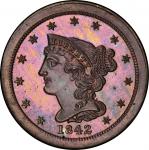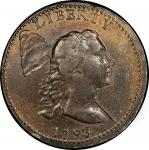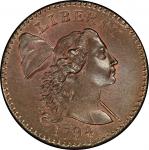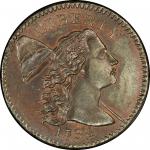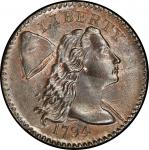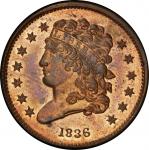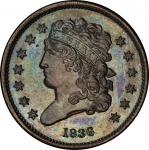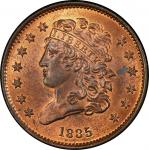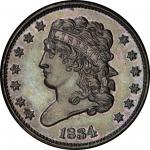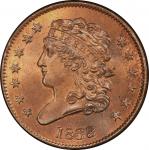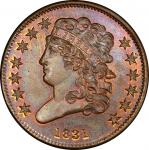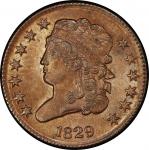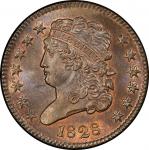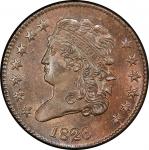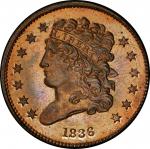Even 1831 and 1836 were restruck with the small berry reverse, proving absolutely that it was the reverse used for restriking. - Charles Steigerwalt, The Numismatist, August 1906Dramatic mint red covers both sides, gently mellowed in the centers of the fields with light pastel hints of green and violet. Both sides show impressive reflectivity, though the reverse fields still show the parallel lines left from finishing and polishing the planchet. The central obverse is significantly swollen, lightly reducing the amount of detail seen among the tresses off Libertys shoulder and below TY of LIBERTY. The obverses issues manifest perhaps more obviously on the reverse, where the lack of a surface to push against has left the central reverse softly struck. The centers of stars on the right side of the obverse are not fully struck up, another byproduct of the obverses slow and subtle failure. A curly lintmark is noted between stars 4 and 5. A substantial wire rim or "fin" is seen around the reverse from 12:00 to 6:00, and a smaller but more square fin is noted around the top of the obverse. Much of the rest of the obverse rim has a beveled appearance, very different in striking fabric from the soft rounding with inherent planchet texture seen on the originals and the more refined square edges of the First Restrikes. No major problems are noted, just some trivial scattered specks and a single tiny contact mark on the rim above T of UNITED on the reverse.While called the "Reverse of 1840," this reverse die actually came into existence in 1856. Henry Chapman recognized this fact in 1911, when he attended the Thomas Elder sale of the William H. Woodin Collection and noted next to this lot "Rev. of 1856." This die was used for the "Second Restrike" Proof half cents, which could have been struck as late as the late 1860s. The estate sale of H.R. Linderman, the Mint director from 1867 to 1869 and 1873 to 1878, included two of the five known of this variety. This coins provenance is traceable back to William H. Woodin, who famously received an enormous hoard of "patterns" from the United States Mint as part of a settlement for two 1877 half union $50 gold pieces. The patterns Woodin received had come from A. Loudon Snowden, who worked elbow to elbow with H.R. Linderman in the production and marketing of patterns, restrikes, and the like. It is no stretch to presume that Woodin would have gotten this coin as part of the Snowden trade. Breen cites no appearance earlier than 1879. This example, traced beyond doubt to 1911, has the longest provenance chain of any of the five known examples, but the possibility of its acquisition in the Snowden trade would extend its provenance back to the Mint itself.There are only five of these. Two were off the market for the better part of a century, even longer in the case of the Byron Reed coin. After its consignment to auction by the Durham Western Heritage Museum, that piece has been in private hands since 1996, while this piece was sold from the Newman/Missouri Cabinet holdings in 2014. The Lyman-Kortjohn coin went into Ted Naftzgers collection, was sold in Stacks session of Auction 89, and is now in the McGuigan Collection. The Brobston-Showers coin and the Anderson-Dupont specimen round out the five, the latter of which was, stunningly, a duplicate in the Missouri Cabinet sale.



